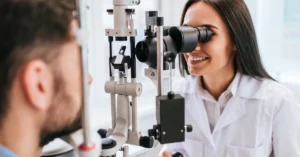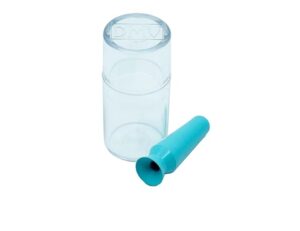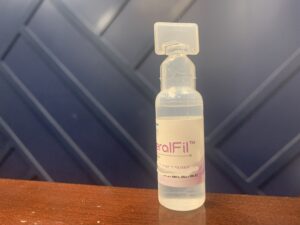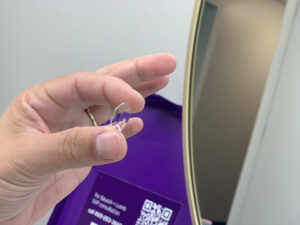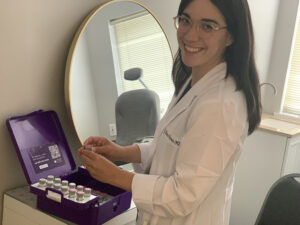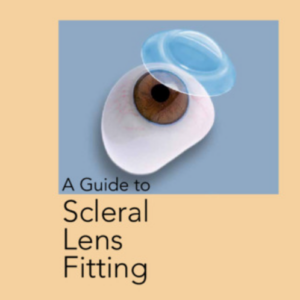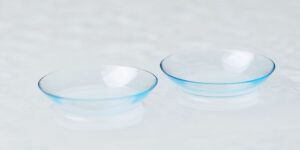Scleral contact lenses have become a popular choice for individuals with specific eye conditions, such as keratoconus, extreme dry eyes, or those who have undergone refractive surgeries like Post Radial Keratotomy (RK). These lenses provide improved vision and comfort by vaulting over the cornea and resting on the sclera, the white part of the eye.
What are Scleral Contact Lenses?
Scleral contact lenses are large-diameter contact lenses that cover the entire cornea and extend onto the sclera. Unlike traditional contact lenses, which rest directly on the cornea, scleral lenses create a tear-filled reservoir between the lens and the cornea. This reservoir helps to provide a smooth optical surface, reducing vision distortions caused by irregular corneal shapes and improving visual acuity.
Scleral lenses offer several advantages over traditional contact lenses. They provide better stability on the eye, making them less likely to dislodge or move during activities. The tear-filled reservoir beneath the lens also helps to keep the eye lubricated, making them an excellent choice for individuals with severe dry eye conditions. Additionally, the larger size of scleral lenses makes them more comfortable to wear, as they do not come into direct contact with the sensitive corneal surface.
Common Issues with Scleral Contact Lenses
While scleral contact lenses offer numerous benefits, they can come with some common issues that users may encounter. These issues include lens fogging, discomfort, and challenges with lens insertion and removal.
One of the primary concerns with scleral lenses is lens fogging. Lens fogging occurs when the lens surface becomes coated with moisture, leading to reduced vision and discomfort. Factors such as temperature changes, humidity, and certain activities can contribute to lens fogging. To overcome this challenge, it’s essential to follow proper lens cleaning and care techniques, as well as utilize anti-fog solutions or drops. For more tips on preventing lens fogging, refer to the section on Tips to Prevent Scleral Lens Fogging.
Discomfort can also be an issue for some individuals wearing scleral lenses. This may be due to inadequate lens fit or improper insertion techniques. Adjusting the lens fit and ensuring proper insertion can significantly improve comfort. Seeking professional help, such as a scleral lens fitting, can assist in finding the right fit and learning the correct insertion methods. For more information on finding a provider near you, check out our article on scleral lenses near me.
Understanding the basics of scleral contact lenses is crucial to effectively address the challenges that may arise. By familiarizing yourself with the purpose and potential issues associated with scleral lenses, you can make informed decisions and seek appropriate solutions to enhance your vision and comfort.
The Challenge of Lens Fogging
Scleral contact lenses offer numerous benefits for patients with keratoconus, extreme dry eyes, and post-RK surgery. However, one common challenge that wearers may face is lens fogging. Fogging occurs when moisture condenses on the lens surface, leading to blurred vision and discomfort. Understanding the causes of lens fogging and its impact on vision and comfort is crucial for finding effective solutions.
Causes of Lens Fogging
Lens fogging can be attributed to several factors. One of the primary causes is a difference in temperature between the lens and the surrounding environment. When warm air comes into contact with the cool lens surface, it leads to condensation, resulting in fogging. Other factors that contribute to fogging include humidity, physical activity, and wearing a mask or helmet that traps warm air near the eyes.
It’s important to note that certain lens care products or cleaning solutions can also contribute to lens fogging. Some solutions may leave behind residue or create a film on the lens surface, making it more prone to fogging. Using the appropriate scleral lens cleaner and following proper cleaning techniques can help minimize this issue.
Impact of Lens Fogging on Vision and Comfort
Lens fogging can significantly impact both vision and comfort for scleral lens wearers. The condensation that forms on the lens surface can cause visual distortion, making it difficult to see clearly. This can be especially problematic in situations that require sharp, focused vision, such as driving or reading.
Moreover, fogging can also lead to discomfort and irritation. The presence of moisture on the lens surface can cause a sensation of wetness or stickiness, making it uncomfortable for the wearer. Additionally, fogging may increase the risk of bacterial buildup or infection if the lenses are not cleaned and disinfected properly.
To overcome the challenges posed by lens fogging, it’s important to implement effective strategies and techniques. In the next section, we will explore tips to prevent scleral lens fogging and provide insights on managing this common issue.
By understanding the causes and impact of lens fogging, scleral lens wearers can take proactive steps to minimize fogging and ensure clear vision and optimal comfort throughout the day. Let’s explore some practical tips and techniques to address lens fogging in the following section.
Tips to Prevent Scleral Lens Fogging
When wearing scleral contact lenses, fogging can be a frustrating issue that affects both vision and comfort. However, there are several tips and techniques you can employ to minimize lens fogging and enjoy clear, comfortable vision. Here are some effective strategies:
Proper Lens Cleaning and Care
Maintaining clean lenses is essential for preventing fogging. Make sure to follow the manufacturer’s instructions for cleaning and disinfecting your scleral lenses. Regularly cleaning your lenses with a scleral lens cleaner or the recommended solution helps remove debris and minimize the risk of fogging. Using a scleral lens plunger or suction cup can also aid in proper lens handling during cleaning and insertion.
Adjusting Lens Fit and Insertion Techniques
Proper lens fit and insertion techniques can significantly impact fogging. Working closely with your eye care professional, ensure that your scleral lenses are fitted correctly to minimize gaps and reduce the chances of fogging. Additionally, learning the correct scleral lens insertion technique is crucial. This involves filling the lens with the appropriate solution, positioning it on the eye, and ensuring a secure fit. A snug fit can help prevent moisture from accumulating and causing fogging.
Using Anti-Fog Solutions and Drops
Anti-fog solutions and drops can be valuable tools for combating lens fogging. These products work by reducing surface tension and preventing moisture buildup on the lens surface. Apply a few drops of an anti-fog solution or use specifically designed anti-fog drops before inserting your scleral lenses. This can help create a protective barrier that minimizes fogging, providing clearer vision and improved comfort throughout the day.
By incorporating these tips into your scleral lens routine, you can effectively reduce fogging and experience optimal vision and comfort. Remember to consult with your eye care professional for personalized advice and to ensure you are using the most appropriate products and techniques for your specific needs. For more information on scleral lenses, visit our article on scleral contact lens.
Note: The effectiveness of these strategies may vary depending on individual factors. It is important to consult with an eye care professional for personalized guidance.
Managing Dry Eyes and Fogging
For individuals wearing scleral contact lenses, managing dry eyes is crucial to prevent fogging and ensure optimal comfort and vision. Dry eye symptoms can contribute to lens fogging, making it essential to address the underlying dry eye condition. Here are some strategies to manage dry eyes and minimize fogging with scleral lenses.
Addressing Dry Eye Symptoms
Treating dry eye symptoms is key to reducing lens fogging. There are several approaches to address dry eyes:
- Artificial Tears: Using preservative-free lubricating eye drops can provide temporary relief from dryness and help reduce fogging. These drops can be used throughout the day as needed.
- Moist Heat Compress: Applying a warm compress to the eyes can help improve tear production and reduce dryness. This method can be particularly beneficial for individuals with evaporative dry eye.
- Blinking Exercises: Regularly practicing blinking exercises helps to spread tears evenly across the surface of the eyes, reducing dryness and improving tear film stability.
- Hygiene and Eye Care: Practicing good eye hygiene, such as avoiding rubbing the eyes and keeping the eyelids clean, can help alleviate dry eye symptoms.
Moisture Retention Techniques
To maintain moisture and minimize fogging with scleral lenses, consider the following techniques:
- Humidifiers: Using a humidifier in your environment can help add moisture to the air, reducing dryness and preventing excessive evaporation of tears.
- Hydrating Eye Mask: Wearing a hydrating eye mask before or after lens wear can help replenish moisture and relieve dryness.
- Avoiding Dry Environments: Limiting exposure to dry and windy environments can help reduce evaporation of tears and minimize dry eye symptoms.
- Proper Lens Cleaning: Ensuring thorough cleaning of your scleral lenses with a recommended scleral lens cleaner is important to remove debris and avoid build-up that could worsen dryness and fogging.
Lubricating Eye Drops and Gels
Using lubricating eye drops and gels specifically formulated for dry eyes can help provide long-lasting relief and improve the comfort of wearing scleral lenses. These products can help maintain moisture on the ocular surface and reduce the occurrence of lens fogging. It’s important to choose lubricating eye drops that are compatible with contact lenses and consult with your eye care professional for guidance on the best options for your specific needs.
By addressing dry eye symptoms, incorporating moisture retention techniques, and using lubricating eye drops or gels, individuals wearing scleral contact lenses can manage dry eyes and minimize lens fogging. Remember to consult with an eye care professional for personalized advice and recommendations. For more information on scleral contact lenses and their fitting process, check out our article on Scleral Lens Fitting.
Troubleshooting Lens Fogging
While there are various measures to prevent scleral lens fogging, it’s important to be prepared for situations when fogging still occurs. In such cases, troubleshooting techniques can help alleviate the issue and ensure optimal vision and comfort. Here are some strategies to consider:
Lens Removal and Reapplication
If fogging persists despite following preventive measures, removing and reapplying the lenses may help. This allows you to inspect the lenses for any debris or residue that could be contributing to the fogging. Make sure to thoroughly clean and rinse the lenses with an appropriate scleral lens cleaner before reinserting them. If needed, you can also check the scleral lens fitting to ensure proper alignment and fit.
Seeking Professional Help and Advice
If lens fogging continues to be a persistent problem, it’s advisable to seek professional assistance from an eye care specialist, such as an optometrist or ophthalmologist. They can examine your eyes, evaluate the fit of the lenses, and provide personalized recommendations to address the issue. They may suggest modifications to your lens care routine, recommend different lens materials, or provide additional treatments for underlying conditions, such as dry eye.
Exploring Alternative Lens Options
In some cases, despite troubleshooting efforts, lens fogging may persist. In such situations, it may be worth exploring alternative lens options. Your eye care professional can guide you in selecting different types of lenses or even consider other vision correction methods that may better suit your needs. Exploring alternative options ensures that you have the best possible vision and comfort while minimizing the impact of lens fogging.
Remember, troubleshooting lens fogging involves a combination of preventive measures, careful lens care, and seeking professional advice when needed. By being proactive and adaptable, you can overcome the challenges of lens fogging and enjoy clear vision and comfortable wear with your scleral contact lenses.

